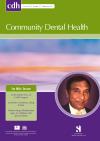Community Dental Health

- Cover Date:
- September 2011
- Print ISSN:
- 0265 539X
- Vol:
- 28
- Issue:
- 3
Tooth wear and erosion: Methodological issues in epidemiological and public health research and the future research agenda
Background: This paper addresses methodological issues in the field of tooth wear and erosion research including the epidemiological indices, and identifies future work that is needed to improve knowledge about tooth wear and erosion. Methods: The paper is result of the work done at the meetings of the Special Interest Group “Tooth Surface Loss and Erosion†at the 2008, 2009 and 2010 conferences of the European Association for Dental Public Health, and the Workshop “Current Erosion indices- flawed or valid†which took place in Basel in 2007. Results: Although there is consensus about the definition and the diagnostic criteria of various forms of tooth wear, gaps in research strategies have been identified. A basic problem is that fundamental concepts of wear and erosion as an oral health problem, have not yet been sufficiently defined. To a certain extent, tooth wear is a physiological condition, and there is no consensus as to whether it can be regarded as a disease. Furthermore, the multitude of indices and flaws in existing indices, make published data difficult to interpret. Conclusion: Topics for the research agenda are: the initiation of a consensus process towards an internationally accepted index, and the initiation of data collection on the prevalence of various forms of wear on a population-based level. There should be an emphasis on promoting communication between basic and clinical sciences, and the area of Public Health Dentistry. Furthermore, the question of whether tooth wear is a public health problem remains open for debate.
Key words: tooth wear, erosion, epidemiology
- Article Price
- £15.00
- Institution Article Price
- £
- Page Start
- 191
- Page End
- 195
- Authors
- C. Ganss, A. Young, A. Lussi
Articles from this issue
- Title
- Pg. Start
- Pg. End
- Investing in professional advocacy: a case study of a successful fluoridation campaign in rural New South Wales, Australia
- 0
- 0
- Tooth wear and erosion: Methodological issues in epidemiological and public health research and the future research agenda
- 191
- 195
- The efficacy of dentifrices on extrinsic tooth stains among community dwelling adults in India – a randomised controlled trial
- 201
- 205
- Clinical and socio-demographic factors influencing the oral health-related quality of life of Chinese elders
- 206
- 210
- The effects of chronic pain on oral health related quality of life in patients with anterior disc displacement with reduction.
- 211
- 215
- Dental self-care and visiting behaviour in relation to social inequality in caries experience
- 216
- 221
- Clinical evaluation of chlorhexidine for the control of dental biofilm in children with special needs
- 222
- 226
- Psychometric properties of long and short forms of the Child Perceptions Questionnaire (CPQ11-14) in a Thai population
- 232
- 237
- Dental examiners consistency in applying the ICDAS criteria for a caries prevention community trial
- 238
- 242
